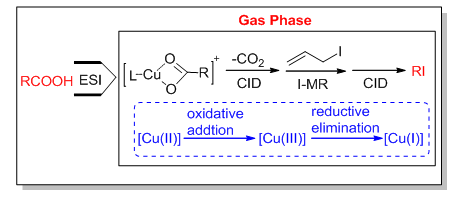| [1] Shepard, A. F.; Winslow, N. R.; Johnson, J. R. J. Am. Chem. Soc. 1930, 52, 2083.
[2] Hubacher, M. H. Anal. Chem. 1949, 21, 945.
[3] (a) Chamchaang, W.; Chantarasiri, N.; Chaona, S.; Thebtaranonth, C.; Thebtaranonth, Y. Tetrahedron 1984, 40, 1727.
(b) Lu, P. F.; Sanchez, C.; Cornella, J.; Larrosa, I. Org. Lett. 2009, 11, 5710.
(c) Cornella, J.; Sanchez, C.; Banawa, D.; Larrosa, I. Chem. Commun. 2009, 7176.
[4] (a) Li, Z.; Zheng, J.; Hu, W.; Li, J.; Wu, W.; Jiang, H. Org. Chem. Front. 2017, 4, 1363.
(b) Yuan, J. W.; Yang, L. R.; Mao, P.; Qu, L. B. Org. Chem. Front. 2017, 4, 545.
[5] Guan, B; Xu, X.; Wang, H.; Li, X. Chin. J. Org. Chem. 2016, 36, 1564(in Chinese). (关保川, 许孝良, 王红, 李小年, 有机化学, 2016, 36, 1564)
[6] (a) Frisch, A. C.; Beller, M. Angew. Chem. Int. Ed. 2005, 44, 674.
(b) Kambe, N.; Iwasaki, T.; Terao, J. Chem. Soc. Rev. 2011, 40, 4937.
(c) Tasker, S. Z.; Standley, E. A.; Jamison, T. F. Nature 2014, 509, 299.
[7] Eisch, J. J. Organometallics 2002, 21, 5439.
[8] (a) Goossen, L. J.; Collet, F.; Goossen, K. Isr. J. Chem. 2010, 50, 617.
(b) Rodriguez, N.; Goossen, L. J. Chem. Soc. Rev. 2011, 40, 5030.
(c) Shang, R.; Liu, L. Sci. China Chem. 2011, 54, 1670.
(d) Cornella, J.; Larrosa, I. Synthesis 2012, 653.
(e) Dzik, W. I.; Lange, P. P.; Goossen, L. J. Chem. Sci. 2012, 3, 2671.
[9] (a) Yamanaka, M.; Kato, S.; Nakamura, E. J. Am. Chem. Soc. 2004, 126, 6287.
(b) Yamanaka, M.; Nakamura, E. J. Am. Chem. Soc. 2005, 127, 4697.
(c) Candish, L.; Standley, E. A.; Gomez-Suarez, A.; Mukherjee, S.; Glorius, F. Chem. Eur. J. 2016, 22, 9971.
(d) Ni, S.; Sha, W.; Zhang, L.; Xie, C.; Mei, H.; Han, J.; Pan, Y. Org. Lett. 2016, 18, 712.
(e) Perry, G. J. P.; Quibell, J. M.; Panigrahi, A.; Larrosa, I. J. Am. Chem. Soc. 2017, 139, 11527.
[10] Nakamura, E.; Mori, S. Angew. Chem. Int. Ed. 2000, 39, 3750.
[11] (a) Bertz, S. H.; Cope, S.; Murphy, M.; Ogle, C. A.; Taylor, B. J. J. Am. Chem. Soc. 2007, 129, 7208.
(b) Hu, H.; Snyder, J. P. J. Am. Chem. Soc. 2007, 129, 7210.
[12] (a) Schroder, D. Acc. Chem. Res. 2012, 45, 1521.
(b) Coelho, F.; Eberlin, M. N. Angew. Chem. Int. Ed. 2011, 50, 5261.
(c) Gronert, S. Chem. Rev. 2001, 101, 329.
(d) Gronert, S. Mass Spectrom. Rev. 2005, 24, 100.
(e) Rijs, N.; Khairallah, G. N.; Waters, T. O'Hair, R. A. J. J. Am. Chem. Soc. 2008, 130, 1069.
[13] (a) Meyer, M. M.; Khairallah, G. N.; Kass, S. R.; O'Hair, R. A. J. Angew. Chem. Int. Ed. 2009, 48, 2934.
(b) Schlangen, M.; Schroder, D.; Schwarz, H. Angew. Chem. Int. Ed. 2007, 46, 1641.
(c) Schwarz, H. Angew. Chem. Int. Ed. 2011, 50, 10096.
[14] (a) Rijs, N.; Yates, B. F.; O'Hair, R. A. J. Chem. Eur. J. 2010, 16, 2674.
(b) Rijs, N.; Yoshikai, N.; Nakamura, E.; O'Hair, R. A. J. J. Am. Chem. Soc. 2012, 134, 2569.
(c) Rijs, N.; O'Hair, R. A. J. Organometallics 2012, 31, 8012.
(d) Sharif, H. A.; Vikse, K. L.; Khairallah, G. N.; O'Hair, R. A. J. Organometallics 2013, 32, 5416.
(e) Rijs, N.; Gonzalez-Navarrete, P.; Schlangen, M.; Schwarz, H. J. Am. Chem. Soc. 2016, 138, 3125.
(f) Geng, C.; Li, J.; Weiske, T.; Schlangen, M.; Shaik, S.; Schwarz, H. J. Am. Chem. Soc. 2017, 139, 1684.
[15] Zhang, X.; Bai, X.; Fang, L.; Jiang, K.; Li, Z. J. Am. Soc. Mass Spectrom. 2016, 27, 940.
[16] Jiang, X.; Huang, H.; Chai, Y.; Lohr, T. L.; Yu, S.; Lai, W.; Pan, Y.; Delferro, M.; Marks, T. J. Nat. Chem. 2017, 9, 188.
[17] Chai, Y.; Shen, S.; Weng, G.; Pan, Y. Chem. Commun. 2014, 50, 11668. |
